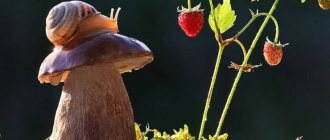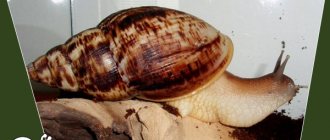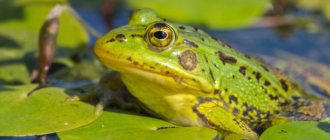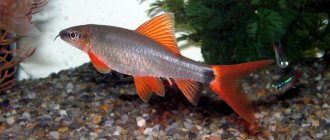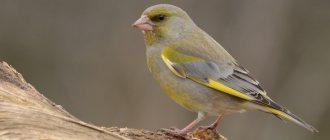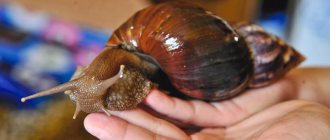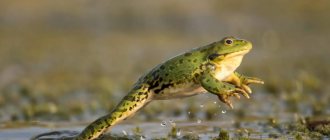Snails, or gastropods, are the most numerous class of mollusks, numbering more than 100 thousand species. A common characteristic feature for all varieties of the class is the presence of an external shell, the size of which allows all the soft parts of the body to be hidden inside.
It is believed that the name “snail” comes from the Proto-Slavic word “hollow”. Due to its relatively small size and special body structure, the question often arises: is a snail an animal or an insect? In the biological classification, all varieties of snails are classified as mollusks, which, in turn, belong to the animal kingdom.
Description and general characteristics of the snail
Tiara
Initially, gastropods were adapted to life in salt water. In the process of evolution, numerous species have appeared living in freshwater bodies and on land. Currently, all representatives of the class are divided into three main groups:
| Group | Habitats |
| Land snails | They lead a terrestrial lifestyle, preferring places with high levels of humidity. Land-dwelling species breathe air. |
| Water snails | Marine, lake and river mollusks that receive oxygen by passing water through their gills. |
| Pulmonary snails | They can be found on land and in water, periodically rising to the surface to breathe. |
The anatomy of gastropods has the following features:
- The main characteristic of snails is torsion. This is called turning the internal sac 180 degrees.
- The nervous system is of a scattered-nodular type. The brain and most of the elements of the system are located in the front of the body.
- The digestive system includes the mouth, crop, stomach, and digestive gland. Due to torsion, the anus is located in the anterior part of the shell.
- Most species have only one kidney.
What does it look like
Grape snail
The external structure of the snail includes:
- Carapace . It is an exoskeleton that is shaped like a cone, spiral, or coil. The shell consists of several organic layers covered with a durable outer layer of calcium carbonate. Mollusks without shells are called slugs.
- head is horned due to two pairs of tentacles located on the head. The two long horns are the eyes (at the ends there are eye spots), and the two shorter ones are the olfactory organs. Mollusks see poorly and use their sense of smell and touch primarily for orientation.
- Leg . The main part of the body expands downward, forming the so-called ventral foot.
Sadovaya
How fast does a snail move?
There is a generally accepted belief that mollusks are the slowest creatures. How fair is this?
Snails move thanks to muscle contractions of the leg. In this case, intensive secretion of secretion from the mucous gland occurs. Mucus allows you to crawl faster on horizontal surfaces and provides reliable grip on surfaces when moving vertically.
Some snails move by crawling, others tear off part of their leg, alternately transferring the center of gravity from the front to the back and vice versa, resembling a caterpillar.
The speed of a gastropod depends on the method of movement, species, and living conditions. Thus, amber snails cover only 1-2 cm per minute, grape snails - 7 cm, trumpeter snails - 16 cm. Mollusks living in rivers and seas are capable of developing much higher speeds than their land-based relatives. The fastest of the snails is the sea butterfly. It is capable of speeds of up to 12 m per minute thanks to two wing-like blades formed during the transformation of the leg.
Housing for your pet and proper care
A street snail can live in an ordinary aquarium, left over from a fish hobby that has not taken root. If you don't have an aquarium, you can use a terrarium or a large plastic container. Soil is poured onto the bottom; enough of it is needed so that the snail can burrow into it, since it serves as a bed for them. The substrate must be wet, but no water should come out when compressed.
Interesting! The soil in the terrarium plays an important role; during breeding, they make nests in it; the softer it is, the easier it is for them to make a place for laying eggs.
In addition, wild garden and forest snails are considered climbers; they often climb walls, and if they fall, the ground protects them from injury. But sawdust cannot be used, as they can eat it.
Read more about what to use as a terrarium and how to equip it for snails
When using store-bought coconut substrate for street snails, it is pre-soaked in water for several hours. When using land, it is taken from a park or forest. It is important that there are no fertilizers or chemicals in it. Before laying the house, it should be calcined at high temperatures or boiled. You can use ready-made soil for begonias from flower shops.
Instead of purchased soil, you can use sphagnum moss or peat, only neutralized. If the peat has high acidity, the forest snail shell will begin to deteriorate quickly.
Read about other types of soil for snails.
A lid is placed on the container. You can’t live without it, since the snail taken from the street is wild and very inquisitive, especially at home. She can run away and get lost. If it falls, it will break the sink or eat the wallpaper on the walls, which is also not allowed.
You can buy a terrarium, soil and other equipment for caring for forest and street snails on Aliexpress.
Types of snails
Neretina
The taxonomy of gastropods is periodically revised with the emergence of new data on the origin and development features of representatives of the class. The latest version of the classification appeared in November 2022.
Below are short descriptions of the most common and interesting gastropod species:
- Grape snail . A medium-sized mollusk with a deep brown shell. Found in most European countries. Meat and caviar are considered a delicacy.
- Reel _ A freshwater aquatic snail that grows to a size of 1-3 cm. The surface of the shell is painted red. Coils are placed in aquariums to remove plaque on the walls and eat dead algae.
- Garden snail. A terrestrial herbivorous mollusk with a light brown shell. It is a pest because it destroys young shoots and fruits of many garden crops.
- Neretina . The mollusk is native to the African continent. The shell grows up to 3-4 cm in diameter and has several color options: brindle, olive, striped. These are common domestic snails that become a real decorative addition to the aquarium.
- Akhatina . The largest land mollusks with a conical shell that has a wide variety of shades. In regions with a temperate climate, it is suitable only for home breeding.
- Luzhanka . A small freshwater mollusk with a brownish-red or brownish-brown shell. Belongs to viviparous species. Distributed in the southern regions of the European continent.
- Forest snail (chain snail). The most common species in Europe. You can identify it by its yellow shell with black stripes.
- Ampularia . An unpretentious aquarium snail native to South America. In favorable conditions it can grow up to 10 cm in length.
- Bitinia . Lives in Europe, Asia and North America. The conical shell is painted dark brown. More than 20 subspecies of the mollusk are known.
- Tiara . An aquarium mollusk with small, needle-like hairs growing on its shell. The hairy snail reaches a length of 2-3 cm and has a yellow or cream color.
Achatina
Land
These are some of the popular types of pets. There are several types of mollusks representing this subgroup. Most land snails belong to the Achatina species. The second most common representative is the grape snail.
Achatina
The size of these gastropods sometimes reaches 25 centimeters. Body color varies from light brown to green. When maintaining, a container with a volume of 25–30 liters is required with the obligatory presence of soil. It must be kept moist at all times. They feed on plants, fruits and vegetables. Banana slices serve as a delicacy. The diet must contain protein foods. Daphnia and gammarus are used as feed.
There are a huge number of varieties of Achatina. Of the most interesting and unusual individuals, the following can be distinguished.
- Achatina fulica is a lazy mollusk. In his free time from eating, he prefers to relax in the house. Its size reaches 20 centimeters. Females are fertile and lay large numbers of eggs. The shell has a conical shape. The colors come in a variety of colors. In the wild, there are individuals of brown, cream and dark color. She leads a terrestrial lifestyle. This type of land snail is capable of laying up to 400 eggs during the breeding season.
- Achatina iradeli is an unusual species of snail, as it has the ability to give birth to viviparity. During the mating process, parents change sex. About 20 snails are born at a time. The color of the shell of the mollusk is yellowish. It uses berries and fruits as food, as well as rotten cabbage leaves. It has pulmonary breathing, which allows the snail to live on land.
Habitat
The lifestyle of snails and the ability to adapt to different living conditions have allowed them to spread almost throughout the world, with the exception of polar and arid desert regions. In nature, the greatest diversity of species is represented in the tropical and subtropical zones.
Luzhanka
Mountain and grape snails are grown artificially on special farms for subsequent consumption and production of cosmetics.
Location
The habitat of snails is scattered throughout the globe. They live in both temperate and hot climates.
The only places where snails are not found are areas covered with ice and waterless deserts. The main criterion for choosing their habitat is high humidity.How long do snails live?
forest chain
The average lifespan of most gastropods is 4-5 years. Some land species live up to 8-10 years. The real long-livers among their relatives are the megas and the grape snail: in favorable conditions, some individuals are able to live up to 15-20 years.
SQUIRREL
How to determine the age of a snail
Ampoules
Mollusks change their appearance depending on the stage of development. First of all, when determining age, you should focus on the size of the shell and the number of turns in it. In some species, the reproductive organ becomes visible after puberty. You can find information that older individuals change their taste preferences or shell color. All known methods make it possible to establish the age of a mollusk only approximately. It is impossible to know exactly the number of years a snail has lived.
Reproduction and lifespan
Grape snails become sexually mature from one and a half to two years. Gastropods are hermaphrodites by nature, containing both male and female characteristics. A prerequisite for laying eggs is the exchange of sex cells between two adults. Mollusks bring offspring 1-2 times a year:
- from March to early June;
- from the beginning of September until October.
To stimulate snail reproduction, breeders place containers in a cold room for several months. Moving into a warm environment signals to your pets that the spring season has arrived.
The mating process of grape snails
Individuals ready to mate differ from others in behavior: they actively crawl in search of a partner and stretch their torso. The meetings end with the soles coming together. Snails lay eggs, bound into cocoons with a gelatinous substance, into the soil.
The soil must be clean, free of pests that can destroy offspring. The babies will hatch in 3-4 weeks at a depth of 6-10 cm. Newborn snails are tiny - only 2-2.5 mm in diameter. The shells are transparent, only two turns. As you grow, the number of turns increases.
The mollusks first feed on their shells, then switch to regular food as they move to the soil surface. The upward journey of the young animals lasts 8-10 days. The lifespan of grape snails is short.
Snail lays eggs
Under natural conditions, the period allotted by nature does not exceed 7-8 years, unless the mollusk is eaten by a predator. In nursery conditions, the life of a gastropod is safe and lasts up to 20 years. The long-lived snail in Sweden has become the record holder, having surpassed the mark of three decades.
How do snails winter in nature?
Most species of land snails that live in regions with seasonally low temperatures hibernate during the winter months. Wintering can begin as early as October and ends in April with the arrival of stable heat.
Before the start of the rest period, animals feed heavily, gaining weight and stocking up on nutrients. Next, the mollusks begin to prepare a place for wintering. Typically, shelter is provided by holes covered with leaves, or specially dug holes. During sleep, the snail seals the entrance to the shell with a mucus plug - the epiphragm.
During wintering, the mollusk's metabolic processes slow down, and the chemical composition of the hemolymph and intracellular fluid changes. This makes it possible to avoid frostbite and survive the cold, using the nutrients accumulated in the fall.
Some species may hibernate during drought or lack of food supply.
How do snails reproduce?
The vast majority of gastropods are oviparous animals. Aquatic mollusks are heterosexual, while land mollusks are predominantly hermaphrodites. Snail reproduction occurs as follows:
- Before laying, eggs are placed in durable capsules;
- all capsules are placed in pre-dug holes, and the number of eggs in one clutch can reach several dozen;
- By the time the larvae mature, the capsule lids dissolve.
Snails are born with a transparent shell, which grows with the body and gradually changes color and becomes more durable.
Among the mollusks there are viviparous species, for example, lemon Achatina and Achatina Kraveni.
What benefits do snails bring?
Bitinia
Gastropods secrete several types of mucus. The most valuable in terms of chemical composition is the one that snails produce during stress or damage to the shell. The properties of this mucus are widely used in cosmetology: creams, masks, and balms are made from it to moisturize and rejuvenate the skin.
JELLYFISH
Mr. Tail Recommends: Natural Habitat
The native habitat of grape snails is open areas of deciduous or mixed plantings, parks, gardens, vineyards, and forests. The soils in such areas are usually alkaline.
In hot weather with minimal humidity, mollusks hide under stones, among the roots of bushes and trees, and burrow into moss and fallen leaves. Stress for them is excessively high and low temperature changes.
In the summer, before sunrise, the snail sticks to the back of a leaf of a tree or bush, which allows it to easily survive the heat of the day.
If a mollusk crawls, it leaves a characteristic slimy trail behind it. This composition protects it, protecting the delicate body from damage.
The birthplace of these creatures of nature is most likely the central and southeastern parts of Europe.
Now the habitat of gastropods of this type has expanded - this is all of Europe (except for the cold northern regions) and the Baltic coast, Australia and southern Russia.
Photo gallery of grape snail:
What do snails eat?
The diet of mollusks largely depends on the species and habitat. Land species eat mainly plant foods: grass, leaves, soft fruits of trees and shrubs. When there is a lack of food supply, they consume decaying vegetation.
There are predators among sea and river snails. Their food includes insects, worms, fish eggs, and shellfish. Some predatory species are capable of releasing a poisonous secretion that paralyzes fry and small fish.
The food of a snail kept at home may consist of cabbage and lettuce leaves, other vegetables and fruits. Mollusks living in aquariums eat algae and fish food.
How many teeth does a snail have?
Gastropods feed mainly on solid food, chewing it with the help of microscopic chitinous teeth - radulas. They can only be seen with significant magnification. In appearance, radulas resemble curved fangs.
As they wear down, new teeth grow on the chitinous film covering the mouth. Their number in different representatives of the class varies from 5 to 25 thousand pieces, while the most dense and durable teeth grow in predators.
Gastropod nutrition
The diet of mollusks is varied and depends on the place of residence. Young individuals prefer fresh plant foods (grape and cabbage leaves, cucumbers, carrots, strawberries, etc.); with age, food preferences may change, and they may begin to eat meat and mushrooms.
Some species prefer to eat carrion. Oddly enough, there are also predatory species that eat various crustaceans and small relatives, as well as various insects.
Marine species (geographical cone) eat fish, using paralyzing poison to neutralize them.
Who eats snails
In their natural habitat, snails' enemies are birds (starlings, jays, chickens, guinea fowl) and predatory fish. They are also eaten by some species of omnivorous mammals: hedgehogs, raccoons, moles. In South and North America, mollusks become food for snail eaters - snakes from the colubrid family.
AXOLOTL
Interesting facts about snails
- The mucus secreted by snails contains the following substances: a powerful skin regenerator allantoin, collagen and elastin that maintain the elasticity of the skin, glycolic acid, and vitamins. After using products based on the secretion of mollusks, a natural filter is created on the surface of the skin that does not transmit ultraviolet radiation.
- The largest land snail in the world is the African giant Achatina, weighing 900 grams. The animal had a length of 39.3 cm, the diameter of the shell was 23.7 cm. Among marine gastropods, the Australian trumpeter is distinguished by its gigantic size. The weight of some specimens reaches 15-18 kg.
- The tropical viviparous tree snail, which lives on the island of Moorea, is recognized as the rarest endangered species and is listed in the international Red Book. Currently, only a few small colonies of these mollusks have been found in their natural habitat.
- The conus snail is the most poisonous snail, the toxins of which pose a danger to humans. The species is found in seas belonging to the Pacific and Indian oceans.
Arrangement of the terrarium
How to care for garden snails in captivity? First of all, they need soil to hide in if necessary. The humidity of the substrate should be such that no water comes out when pressing on it.
It is better to use soil from the place where the snail was taken. The layer of soil not treated with pesticides should be sufficient for the mollusk to burrow completely into it.
Flower soil is not suitable for creating a terrarium substrate. It contains chemical additives that are harmful to shellfish.
Sphagnum moss, vermiculite, compost or peat work well as a soil covering. They absorb and retain moisture well, which prevents the substrate from drying out. Such conditions for keeping garden snails are as close to natural as possible, which contributes to their normal life.
An untreated snag or branch placed in a terrarium will greatly help a garden snail feel “at home.” The mollusk will always be able to find shelter under it if it senses danger. He also likes to hide in damp fallen leaves and spends most of his time in such a “shelter”.
Don't forget to put a lid on the terrarium. A wild garden snail is no less inquisitive than a domestic one, so it quickly crawls out of any uncovered container. The impact of a fall on the floor often results in chips and cracks in the sink.
